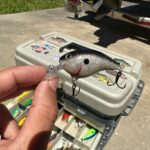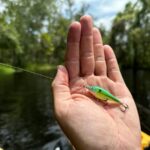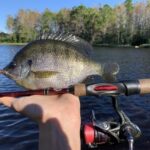Spend a little time around bass anglers, and it won’t take long to hear about the magical ‘Senko Worm‘.
Perhaps no other soft bait/worm style lure has made such an impact in the world of freshwater fishing.
In this complete guide, i’ll cover everything you need to know about Senko fishing.
It doesn’t matter if you are a beginner or a veteran angler…I promise there is something to learn about the versatile and effective Senko worm.
This page contains affiliate links. As an Amazon Associate, I earn from qualifying purchases.
Table of Contents
What Is a Senko?
The Senko is a soft-plastic stickbait (or stick worm) sold by Yamamoto Custom Baits.
The Senko was designed by Japanese-American Gary Yamamoto in the 1990s. Originally, it was intended to be a soft jerkbait style lure, like a Zoom Fluke, but later, Yamamoto discovered it worked better with a slow and finesse sinking technique.
The Senko was first picked up by tournament bass anglers, where it gained popularity fast, and it gained a reputation for catching bass without having to impart any action to the lure.
The Senko was doing all the work catching bass, and the anglers barely had to do anything.
The magic of the Senko is its natural action as it falls weightlessly. On the fall, the Senko wobbles subtly which entices bass to bite.
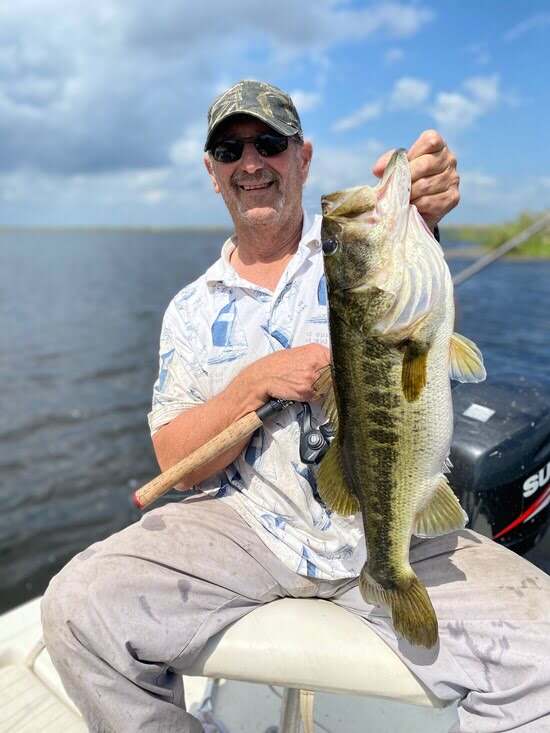
Even the laziest bass can’t seem to resist a Senko sinking slowly through the water.
Ever since, the Senko has been extremely popular in bass fishing tournaments and among recreational anglers.
As a result, many other fishing lure brands have created extremely similar style lures to capitalize on the success of the Yamamoto Senko.
What Can You Catch on a Senko?
The Senko was designed to catch bass, and catch bass it does! The Senko works best for largemouth, smallmouth, and spotted bass.
The Senko catches bass of all sizes. Untold amounts of double-digit bass have been caught on the Senko.
In fact, even a world record spotted bass, weighing over 10lbs, was caught on a Senko in California.
The Senko works best for bass, but other species of predatory fish have been known to hit the Senko on occasion. Pickerel, warmouth, and green sunfish will hit Senkos.
I’ve even caught black crappie, bowfin, and longnose gar on a Senko!
If it swims in freshwater…there is a good chance it will bite a senko.
What Are the Different Types of Senkos?
There are several sizes and variations of Senkos available from Yamamoto Baits. Other brands have since come out with their own versions, inspired by the original Senko.
The original Yamamoto Senko was 5 inches long, but they are also available in 3, 4, 6, and 7 inches long.
Different-sized Senkos can work better for some species than others.
For example, the standard 5-inch Senko is the all-around favorite for targeting largemouth bass and smallmouth bass.
The three-inch Senko would work particularly well to target Suwannee bass, Guadalupe bass, or even some trophy-sized warmouth and green sunfish.
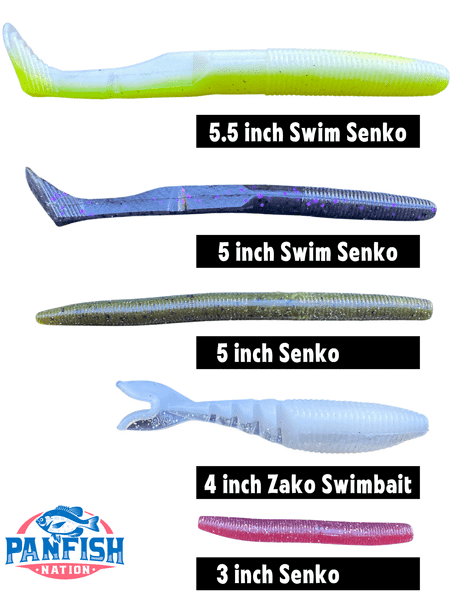
Yamamoto Baits offers several other styles of Senko. There is a Fat Senko, a Slim Senko, and Thin Senko. There is also a Pro Senko which was designed for shaky-head jigs; its design features a thicker head and long slender tail.
Yamamoto Baits also has a Swim Senko. This is simply a Senko with a paddle tail which turns it into a swimbait, hence the name Swim Senko (one of my favorites!).
In the past few years, Gary Yamamoto also released the Zako Swimbait, which makes an excellent trailer to swim jigs and chatterbaits, or fished weedless on its own.
Recently, the ned rig has been very popular, so Yamamoto Baits now offers a new special 3-inch Ned Senko. This bait is designed to float and stand straight up when put on a Ned Rig.
How To Rig A Senko
You can’t fish a Senko wrong…and honestly, sometimes doing less is more. But these are some of the most effective ways to rig a Senko.
The Yamamoto Senko, has a slightly curved concave shape. Whichever rig you use, you want to rig it so that this curved end is on the bottom. That way, it catches more water and has a better wobble action on the fall.
Texas Rig
The Texas rig utilizes a weedless hook, preferably a round bend or extra-wide gap hook. For the 5 inch Senko, use a 3/0 size hook.
Adjust your hook size up or down depending on the size Senko you are fishing.
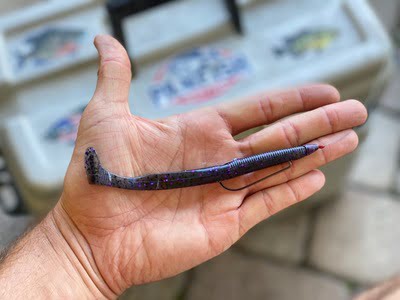
This rig excels around snags and weeds, so you should skin hook the Senko with the hook to rig it weedless. You can fish the Texas rig weightless or with a weight.
I like to add a bobber stopper to keep my bullet weight from sliding up and down my line.
Remember, in most cases, the Senko works best with a slow natural fall, so as a general rule, you should try to use the least amount of weight possible. That way, you will get the most bites.
Wacky Rig
The Wacky rig hooks the Senko through the middle of the body, so it pulses in a really unique way.
You can use a number of different hook styles with this bait, and the choice of hook depends on how strong your line is.
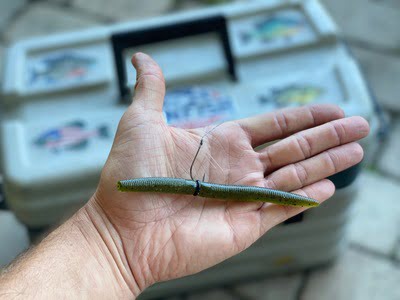
For most applications, I’ll use a light wire finesse hook, but if Wacky rigging around weeds, I’ll use a heavier line and a thicker gauge hook with a weed guard.
The Wacky rig lets the Senko wiggle and wobble on the fall. This style is incredibly tantalizing on the fall, and bass cannot resist it!
Carolina rig
The Carolina rig features a swivel, a sliding weight above the swivel, and a leader. This rig excels in deep water.
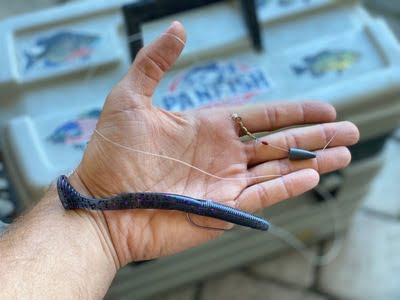
A longer leader up to three feet can be used, and this helps the Senko sink naturally in deep water.
However, the longer the leader, the harder it will be to cast the Carolina Rig.
Drop Shot Rig
The drop-shot rig puts the hook up the line and a special drop shot weight at the bottom. This lets you hold the Senko in place and wiggle it in front of a fish.
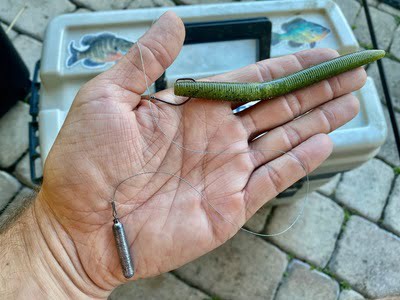
The drop shot excels on suspended fish above the bottom. It is also great for deep water or cold water applications.
How to Fish the Senko Worm
The secret to fishing the Senko worm is to let the bait do all the work. Don’t overcomplicate your retrieve, instead cast it out, let it sink, rinse and repeat. Experiment with different speeds, but be subtle and fish it slowly.
Watch your line for bites, because most of the bites are on the fall. When your Senko hits the bottom, give the lure a couple of twitches, and then let it sink again.
Repeat this slowly and methodically.
Experiment with different timing; sometimes, on very hot/cold days when the bass are lethargic…I may let it sit for 5-10…even 15 seconds before giving it a twitch!
You can slowly raise your rod tip, or give it a quick ‘pop‘ upwards before letting it sink again.
The goal is to let the senko worm rise and fall naturally in the water column…but experiment with different speeds, tempos, and movements until you get a bite.
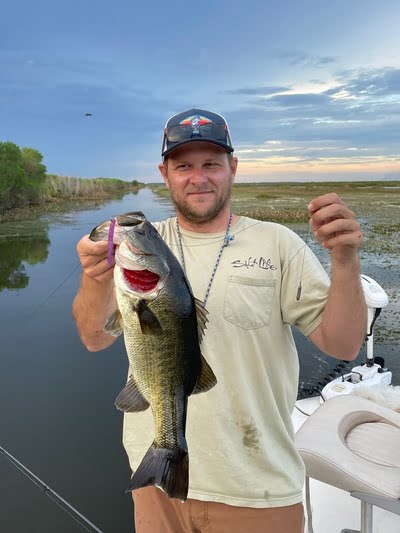
Once you find what works, repeat the process. And take note as to the conditions that day, and how the bass responded.
Other styles of Senko, like the Swim Senko, should be fished on a more steady retrieve to get that paddle tail kicking.
A steady retrieve action can be fished fast (on or near the surface of the water creating a wake action)…or fished slow, in the middle of the water column through weeds and stumps.
Senko vs Trick Worm
Some anglers may be wondering what is the difference between a Senko vs trick worm…after all, aren’t they both finesse-style stick baits?
Well, yes and no. As you can see from this video, the Senko has a much more delicate ‘wobbling‘ action that most trick worms do not.
Additionally, Senkos are injected with a proprietary amount of salt content and scent, which bass seem to absolutely love.
Senko worms have set the standard for other tricks worms and finesse-style baits…not the other way around.
Does that mean a trick worm is better than a Senko? No, not necessarily. Trick worms are their own caveat of soft baits and can be very effective…
My take: Why not have both!
Best Senko Rods
Senko fishing is so popular that some manufacturers have come out with rods designed specifically for Senko fishing.
Does that mean you need a special Senko rod to fish a Senko worm? Of course not!
But, if you like specialized gear to serve a particular purpose, check out the St. Croix Mojo Bass Rod.
It’s specifically designed to cast weightless senko as light as 1/8 of an ounce, yet powerful enough to turn big bass, even in moving water. Its simply a fantastic Senko or finesse style spinning rod.
I recommend anything from the 6’8″ to the 7′”1″ in medium to medium-light power.
Frequently Asked Questions
Why Are Senkos So Popular?
The Senko became popular because of how incredibly effective it is. Fishing a Senko is so easy that you can catch fish with this bait bydoing nothing.
You can’t fish it wrong, and it works when many other lures just won’t get bites.
What is the Best Color Senko?
The Yamamoto Senko is offered in over 150 colors, but I like to keep it simple. I mostly use solid black, green pumpkin, junebug, or something similar.
Depending on the water clarity, and depth I am fishing I experiment with other colors and patterns like electric shad, chartreuse, or even pink.
Lure color does matter!
What is the Best Senko Worm for Bass?
The 5-inch Swim Senko is the most versatile Yamamoto worm for bass. It combines the unique swimming action of a paddle tail bait, with the subtlety of a stick worm.
I’ve caught countless largemouth bass on a weedless 5-inch Swim Senko worm in open water, shallow flats, or thick cover.
What Size Hooks for Senkos?
It really depends on the size of the Senko and the rig you are using. For a 5 inch Senko texas rig, I use a 3/0 EWG. For a wacky rig, I use a size 1/0 size hook with weed guard.
You should upsize or downsize your hook depending on the size of your Senko. For the 7 inch Senko, I would use a 5/0 EWG hook for a Texas or Carolina rig.
What Size Weight for Senkos?
Your best bet is no weight at all! The Yamamoto Senko is incredibly dense because it is filled with salt. This means there is plenty of weight already in the bait to cast it.
A weightless fall gets the most bites, so you should avoid using weight if you can.
However, if you need to reach deeper areas or punch into structure, you can add some weight. First, start with light weights, like a 1/8th oz bullet weight, and add more if necessary.
On windy days, more weight is necessary for casting distance and keeping your line taught.
I prefer to use Tungsten bullet weights because they have a smaller profile since they are much denser than lead (and better for the environment!)
What Is the Best Line Type for Senko Fishing
The line type depends on your style of fishing. Fluorocarbon is generally considered as the best all-around line for Senkos, but braid to leader has its advantages too! If you’re fishing in thick grass, you’re better tying straight braid most of the time.
I used to fish braid to a fluorocarbon leader on all my Senko rigs, but I no longer think that it’s necessary unless im in extremely clera water.
Now, I mainly fish straight braid on my Swim Senko rigs or punching rigs, and fluorocarbon on my Senko drop shot rigs.
See Also: Choosing The Best Fluorocarbon Line For Baitcasters
Can You Use Senkos as a Jig Trailer?
Yes you can use Senkos as a jig trailer, and it works really well. Football head jigs work nicely with a Senko on the back. You can also fish Senkos on a shaky head jig.
The Swim Senko works nicely on the back of a swim jig, spinnerbait, or Jack Hammer Chatterbait.
What Other Worms Are Similar to the Senko?
As the Yamamoto Senko grew in popularity, other bait makers started making their own soft stickbaits, similar to the original Senko. Other brand stickbaits are often dubbed as ‘Senkos‘.
Senkos from other brands can produce very similar results, but none are truly as revolutionary as the original Yamamoto Senko. Some other popular soft-plastic stickbaits are the Yum Dinger, Zoom Zlinky, Gambler Fat Ace, and Googan Lunker Log.
Some other brands have made their own modifications to the Senko by adding a tail appendage.
For example, the Zoom Speed Worm has a short vibe tail, and the Zoom Fluke Stick adds a split tail. Both of these have added something new to the classic Senko style body.
Compared to other brands, the Yamamoto Senko has a higher salt content. The high amount of salt increases the Senkos density making it heavier. As a result, it is easier to cast, and it sinks faster than similar baits with less salt.
However other brands of senko style baits are more affordable and are a good option on a budget.
How Do You Store Senko Worms?
The best way to store Senko worms is in their original packaging, out of direct sunlight. A simple worm binder works well, or a hard case tackle box.
During periods of extreme cold or extreme heat, bring your Senkos and other soft baits in the house or garage.
The fluctuations in temperature can make them brittle or dry out the salt content.
How Do You Make Senkos Last Longer?
The original Yamamoto Senkos are really soft. That’s why they work so well, but they also tear very easily.
When the bass are biting really good, I can go through a whole pack of Senkos after 10 bites!
A number of useful products have been developed to increase the longevity of your Senkos.
For wacky rigging, most anglers use O-rings to hold their bait on the line. Other products are available, such as the VMC Crossover Rings, which function similarly.
These senko saddles are very effective at increasing your Senko longevity.
Other brands have developed soft plastic senko style stick worms which are made to be very durable.
Z-Man makes an ElaZtech Senko called the ZinkerZ, and Savage Gear makes the Armor Tub, a Senko with an internal mesh to increase longevity.
Can You Make Your Own Senko Worms?
Another way to save money is to make your own Senko worms using an injection mold kit.
You can buy Senko worms molds in different styles and configurations, and then use your favorite colors to create customized baits.
You’ll need to experiment a bit with the plastic ratios and salt content, but making your own homemade lures is a ton of fun and very rewarding!
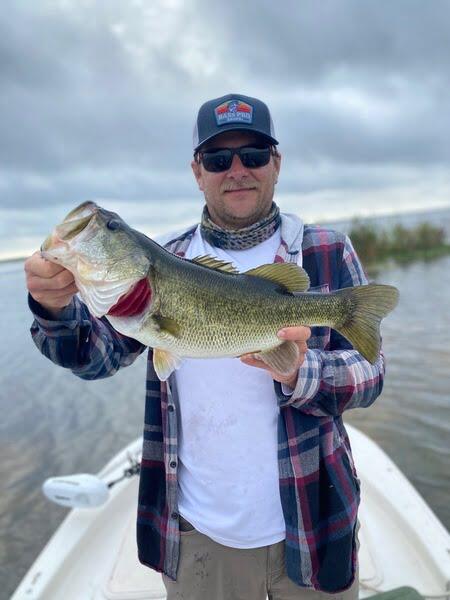
Final Thoughts
In my opinion, the Senko worm by Gary Yamamoto is the most revolutionary soft bait lure to hit the market in the past 50 years.
Whether you are fishing the swamps of Florida, the deep reservoirs of Appalachia, or the gin-clear waters of the upper midwest…the Senko worm is unmatched in its effectiveness and reliability.
Let me put it this way…If I had to choose 1 soft bait lure to fish with for the rest of my life…it would be the Senko worm. Period!
I hope this article helped answer some of your questions…now go grab a pack of Senkos and catch some bass!
You May Also Like: Are Largemouth Bass Good To Eat? & Should You Keep Them?
If you haven’t guessed yet, I love fishing and everything about it!
To learn more about why I started Panfish Nation, visit the About page and follow along on Social Media:


Download a copy of my FREE Lure Color Selection Chart & Knot Guide!
Stay up to date with fishing reports, tackle reviews, industry news, and much more! We respect your privacy, unsubscribe at any time.
Like this post? Save it on Pinterest.

Related Posts
- What Size Hooks for Smallmouth Bass? Quick Guide
- Large and in Charge-Mouth: 10 of the Best Bass Lures of All Time (And Where to Buy Them)
- The Seven Best Lures for Fall Bass Fishing
- Which Fishing Line is Best for Bass Fishing With A Spinning Reel?
- What Size Hooks for Panfish?
- What Is The Best Fishing Line For Bluegill?



